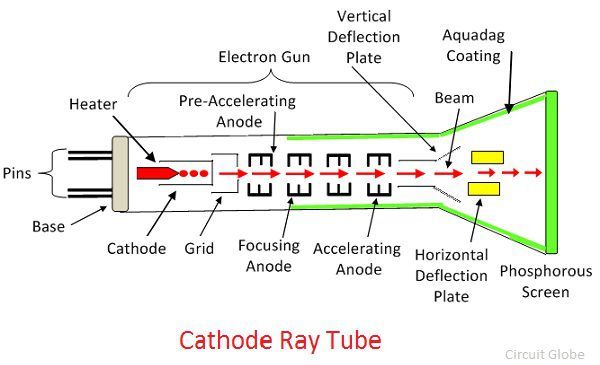Definition: The CRT is a display screen which produces images in the form of the video signal. It is a type of vacuum tube which displays images when the electron beam through electron guns are strikes on the phosphorescent surface. In other Words, the CRT generates the beams, accelerates it at high velocity and deflect it for creating the images on the phosphorous screen so that the beam becomes visible.
Working of CRT
The working of CRT depends on the movement of electrons beams. The electron guns generate sharply focused electrons which are accelerated at high voltage. This high-velocity electron beam when strikes on the fluorescent screen creates luminous spot
After exiting from the electron gun, the beam passes through the pairs of electrostatic deflection plate. These plates deflected the beams when the voltage applied across it. The one pair of plate moves the beam upward and the second pair of plate moves the beam from one side to another. The horizontal and vertical movement of the electron are independent of each other, and hence the electron beam positioned anywhere on the screen.
The working parts of a CRT are enclosed in a vacuum glass envelope so that the emitted electron can easily move freely from one end of the tube to the other.
Construction of CRT
The Electrons Gun Assembly, Deflection Plate Assembly, Fluorescent Screen, Glass Envelope, Base are the important parts of the CRT. The electron gun emits the electron beam, and through deflecting plates, it is strikes on the phosphorous screen. The detail explanation of their parts is explained below.
Electrons Gun Assembly
The electron gun is the source of the electron beams. The electron gun has a heater, cathode, grid, pre-accelerating anode, focusing anode and accelerating anode. The electrons are emitted from the highly emitted cathode. The cathode is cylindrical in shape, and at the end of it, the layer of strontium and barium oxide is deposited which emit the high emission of electrons at the end of the tube.
The electron passes through the electron in the small grid. This control grid is made up of nickel material with a centrally located hole which is coaxial with the CRT axis. The electron which is emitted from the electron gun and passes through the control grid have high positive potential which is applied across the pre-accelerating and accelerating anodes.
The beam is focused by focusing anode. The accelerating and focusing electrodes are cylindrical in shape which has a small opening in the centre of each electrode. After exiting the focusing anode, the beams passes through the vertical and horizontal deflecting plates.
The pre-accelerating and accelerating anode are connected to the positive high voltage of about 1500V and the focusing anode are connected to the lower voltage of about 500V.There are two methods of focusing the electron beam. They are the Electrostatic Focussing Beam and the Electromagnetic Focusing.
Electrostatic Deflection Plates
The deflection plate produces the uniform electrostatic field only in the one direction. The electron beam entering into the deflection plates will accelerate only in the one direction, and hence electrons will not move in the other directions.
Screen For CRT
The front of the CRT is called the face plate. The face plate of the CRT is made up of entirely fibre optics which has special characteristics. The internal surface of the faceplate is coated with the phosphor. The phosphorous converts the electrical energy into light energy. The energy level of the phosphorous crystal raises when the electron beams strike on it. This phenomenon is called cathodoluminescence.
The light which is emitted through phosphorous excitation is called fluorescence. When the electron beam stop, the phosphorous crystal regain their original position and release a quantum of light energy which is called phosphorescence or persistence.
Aquadag
The Aquadag is the aqueous solution of graphite which is connected to the secondary of the anode. The Aquadag collects the secondary emitted electrons which are necessary for keeping the CRT screen in the state of electrical equilibrium.


NYC. And correct information … Thanxx
Pls post working of CRT
SIR PLEASE GIVE THE GRAPHICAL REPRESENTATION OF CRT
Can you please provide me the answer of the use of focusing system in Cathode Ray Tube ?
thank you
THANKS, for this superb explanation.
it was nice to know about CRT
A very clear explanation of CRT! Thank you!!!
Very informative and comprehensive article.
I have been looking for a such detailed explanation. Thank you
Thanks for this contribution
It helps me a lot 🙂
Thank u
Very much informative and clear🙏🏿
Thanks so much, is a nice one